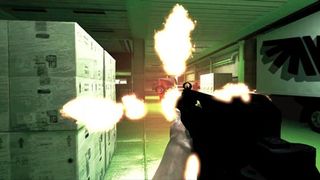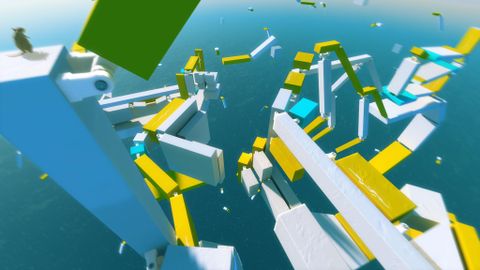Mirror’s Edge is all about momentum. Run on the flat for more than a few steps and Faith picks up speed, her slip-slapping footfalls getting closer together, her breath louder and her vision motion-blurred at the periphery. The challenge is preserving this momentum as you duck pipes, scale crates and leap between rooftops. Timing is the key: vaulting for a handhold rather than running flush into a wall, or rolling out of a high jump without a screen-reddening crunch. Nail a few in a row and you’ll begin to see the game’s attraction: speed, agility, grace, immersion. Coupled with the first person perspective, this makes stringing together a flat-out run genuinely exhilarating. The vertigo-spinning heights make you realize how drawn into the game the wide-angle view and clean display allow you to be.

Without a heavy block of metal coughing death and thunder from the center of the screen – which, in conventional shooters, understandably becomes the focus of your attention – it’s amazing how much you can take in. Or more importantly for Mirror’s Edge, how much there is to take in: the echoing rooftop silence, broken only by the hum of distant traffic and an occasional bird’s flutter; or the game’s stern, assured use of color. The city’s dystopian whiteness is broken only by stark, single-tone themed levels – the grimy green of a chasmal storm drain, the deep polished blue of an illegally-entered office. It’s an assured and stylish palette, elaborated by streaks and flashes of red as Faith’s runner vision singles out obstacles and paths for her to dash over and across (which, while strictly speaking a bit of a cheat, adds to rather than spoils the game’s looks, and is used increasingly sparingly as the game goes on).
There are slower bits: puzzling route-finding breathers, cramped creeping through air vents and big, grandstanding jumps that can take a few goes to get right (the repeated sound of Faith’s splintering limbs beating like a macabre tambourine). These lack the thrill of the chase moments, but retain the novelty and uniqueness of the rest of the game. Perhaps the most important thing of all is that the whole package – the controls, the responsiveness, the perspective – works so effectively together that when you mess up, it feels like it’s your own fault. When you fall, it doesn’t feel like you’re struggling with a broken machine, it just feels as if you’re too clumsy to control this beautiful new thing.
Well, that’s true when you’re running, at least. The only real problems with Mirror’s Edge emerge when you slow down. Throughout the game you’re chased constantly by the police or the city’s sinister private security, both on foot and by choppers in the air. They shoot at you relentlessly, which gives everything a genuine sense of danger and pace, but if you start to slow down out in the open they’ll tear you to shreds. Granted, this doesn’t happen often – you can usually run through them and you’re pretty much untouchable at top speed anyway. But on a couple of occasions – one late-game descent of a series of office-block stairways in particular comes – it feels as if you’ve no alternative but to take everyone out, a task which is haphazard and difficult. Faith can disarm opponents when their guns go red during melee attacks, but when the enemies get tougher it feels imprecise and unfair (much like the dog attacks in COD4).

More importantly, even though the gun play effects themselves are totally fine (and sound brilliantly brash and loud), it just feels awkward and wrong alongside what else is here. This game isn’t built for guns; it’s built on the graceful premise of throwing them away – and when you’re forced into using them, the results can be painful. These few moments aside, though, Mirror’s Edge is an extraordinary and special game. It’s beautiful and stylish like nothing else on consoles, and skews the over-worked mechanic of first person shooting in a new, daring and – when it clicks – brilliant direction. It’s inventive, gorgeous and cool. You’d be mad not to give it a go.
Nov 10, 2008

